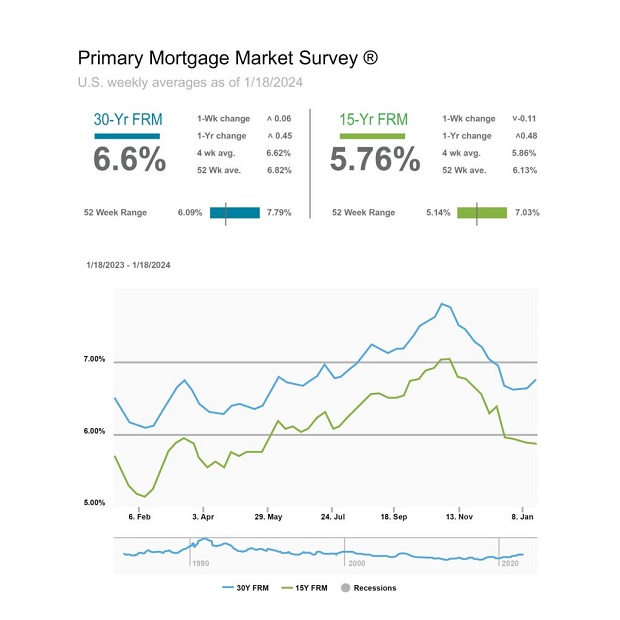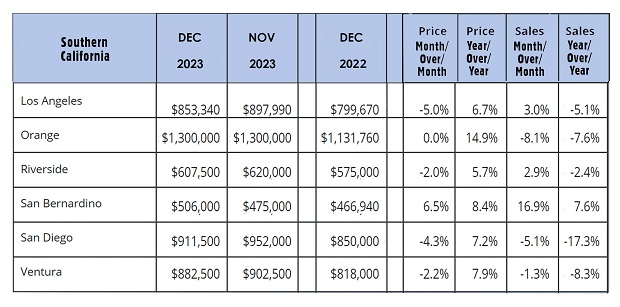| Stock markets – This week marked another week of strong economic data. December retail sales, a gauge of consumer confidence was much stronger than analysts had expected. Strong consumer spending puts pressure on inflation. New weekly jobless claims also dropped to the lowest level in almost two years. It had seemed that after eleven rate increases in just over a year, boasting the prime lending rate, an index that many business loans are tied to, from 3.5% to 8.5% was beginning to slow hiring and spending. These reports, like others this month, indicate that the economy may be picking up steam. Good news for the economy is not always good news for interest rates. The Fed needs to see signs that the economy is slowing to drop rates from their current 24-year high levels. These reports indicate that rate drops will not be as soon as many investors had hoped for at the end of 2023. The Dow Jones Industrial Average closed the week at 37,863.80, up 0.7% from 37,592.98 last week. It is up 0.5% year-to-date. The S&P 500 closed the week at 4,839.81, up 1.2% from 4,783.83 last week. The S&P is up 1.5% year-to-date. The Nasdaq closed the week at 15,310.97, up 2.6% from 14,927.76 last week. It is up 2% year-to-date.
U.S. Treasury bond yields – The 10-year treasury bond closed the week yielding 4.15%, up from 3.96% last week. The 30-year treasury bond yield ended the week at 4.36%, up from 4.20% last week. We watch bond yields because mortgage rates follow bond yields. Mortgage rates – Every Thursday Freddie Mac publishes interest rates based on a survey of mortgage lenders throughout the week. The Freddie Mac Primary Mortgage Survey reported that mortgage rates for the most popular loan products as of January 18, 2024, were as follows: The 30-year fixed mortgage rate was 6.60%, down slightly from 6.66% last week. The 15-year fixed was 5.76%, down slightly from 5.87% last week. Mortgage rates were higher at the end of the week. Next week’s rates will be higher. The graph below shows the trajectory of mortgage rates over the past year.
Freddie Mac was chartered by Congress in 1970 to keep money flowing to mortgage lenders in support of homeownership and rental housing. Their mandate is to provide liquidity, stability, and affordability to the U.S California Association of Realtors 2023 existing-home sales report – The California Association of Realtors reported that existing-home sales totaled 224,000 units on a seasonally adjusted annualized basis in December, down 7.1% from a revised 241,700 homes sold on an annualized basis last December. California recorded 257,560 existing-homes sold in 2023, down from 342,530 homes sold in 2022. That marked the biggest one-year drop in annual sales since 2007. Prior to 2022 home sales have rarely dropped below 400,000 in decades. Much of the decline was due to a loss of move-up buyers. Normally about 60% of all sales are people who sell a home and use their proceeds to purchase another. When someone who wants to move has a mortgage rate of 3% it’s difficult to sell it and purchase another with a mortgage at a 7% rate. This is because when they own a $2 million dollar home with a $1 million mortgage at 3%, their payment with taxes and insurance is about $4,500 a month. If they put their $1 million in proceeds down on a new $4 million dollar home and obtained a $3 million loan at 6.5% (down from almost 8% two months ago) their payment with tax and insurance would be around $24,000 a month. That’s a big jump that has caused many people to stay in their current homes that would normally move to a new home. When people put off their move it reduces the number of homes for sale. There was a 2.5-month supply of homes on the market in December, down from a 3-month supply of homes for sale in November, and a 2.6-month supply one year ago. That marked the tightest inventory level in 7 months. Fewer homes for sale, especially in a first-time buyer price range push prices up for those homes. This is exactly what is happening now. At the same time, without the move-up buyers, homes in the upper ranges of many areas are sitting. Those are being reduced and sold for less than they did in 2022. Because there are many more sales in the lower price range than the upper price ranges the median price, the point at which 1/2 the homes sell for mom and 1/2 sell for less, is moving up. The statewide median price paid for a home in December was $819,740, up 6.4% from a revised median price of $770,490 a year ago. In the field we are not seeing home prices increase in the upper price ranges the way we are seeing the first-time purchaser home prices jump. The graph below shows home sales figures by county in Southern California.
Have a great weekend! |
News & Media


